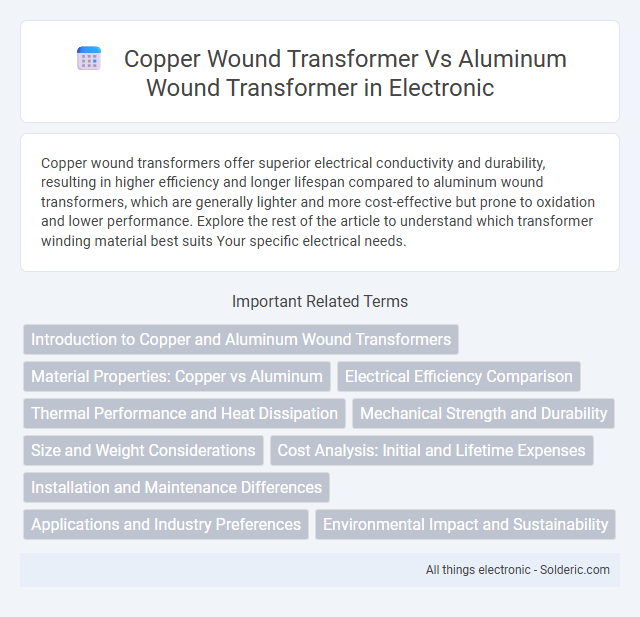Copper wound transformers offer superior electrical conductivity and durability, resulting in higher efficiency and longer lifespan compared to aluminum wound transformers, which are generally lighter and more cost-effective but prone to oxidation and lower performance. Explore the rest of the article to understand which transformer winding material best suits Your specific electrical needs.
Comparison Table
| Feature | Copper Wound Transformer | Aluminum Wound Transformer |
|---|---|---|
| Conductivity | Higher electrical conductivity (59.6 MS/m) | Lower electrical conductivity (36 MS/m) |
| Weight | Heavier due to higher density (8.96 g/cm3) | Lighter with lower density (2.70 g/cm3) |
| Cost | Higher material cost | Lower material cost |
| Durability | More durable and resistant to fatigue | Less durable, prone to oxidation |
| Efficiency | Higher efficiency due to better conductivity | Lower efficiency, increased losses |
| Thermal Performance | Better heat tolerance and dissipation | Poorer thermal conductivity |
| Mechanical Strength | Higher tensile strength | Lower tensile strength |
| Common Applications | High-performance, compact transformers | Cost-sensitive, lightweight applications |
Introduction to Copper and Aluminum Wound Transformers
Copper wound transformers offer superior electrical conductivity and thermal efficiency compared to aluminum wound transformers, resulting in reduced energy losses and enhanced performance in power distribution. Aluminum wound transformers are lighter and more cost-effective due to the lower price and weight of aluminum, making them suitable for applications where budget and weight restrictions are critical. Both types require careful consideration of conductivity, mechanical strength, and installation environment to optimize transformer efficiency and longevity.
Material Properties: Copper vs Aluminum
Copper wound transformers exhibit higher electrical conductivity, approximately 59.6 million siemens per meter, compared to aluminum's 37.7 million siemens per meter, resulting in lower electrical resistance and improved efficiency. Copper's superior tensile strength and thermal conductivity enhance durability and heat dissipation, reducing the risk of overheating during operation. Aluminum, being lighter and less costly, offers weight savings and economic benefits but requires larger conductor sizes to carry equivalent current due to its lower conductivity.
Electrical Efficiency Comparison
Copper wound transformers offer superior electrical efficiency compared to aluminum wound transformers due to copper's higher conductivity and lower resistance, resulting in reduced energy losses during operation. Aluminum windings tend to have higher resistive losses, which can increase heat generation and reduce overall transformer efficiency. Choosing a copper wound transformer can enhance your system's energy savings and performance, especially in applications requiring consistent and reliable power delivery.
Thermal Performance and Heat Dissipation
Copper wound transformers exhibit superior thermal performance due to copper's higher electrical conductivity and lower resistivity, resulting in less heat generation during operation. This enhanced heat dissipation capacity helps maintain lower operating temperatures and ensures better longevity and reliability for your electrical systems. Aluminum wound transformers, while lighter and less expensive, typically experience higher thermal losses and require more robust cooling mechanisms to manage heat effectively.
Mechanical Strength and Durability
Copper wound transformers exhibit superior mechanical strength and durability due to copper's higher tensile strength and resistance to deformation under stress. Aluminum wound transformers, while lighter, have lower mechanical robustness and can be more susceptible to wear and damage from mechanical vibrations and thermal expansion. Copper's enhanced durability also contributes to longer operational life and reduced maintenance requirements in demanding electrical environments.
Size and Weight Considerations
Copper wound transformers typically offer higher conductivity, allowing for smaller and lighter designs compared to aluminum wound transformers. This results in a more compact transformer that can be advantageous in applications with strict size and weight constraints. Your choice between copper and aluminum windings will directly impact the transformer's overall efficiency and portability.
Cost Analysis: Initial and Lifetime Expenses
Copper wound transformers have higher initial costs due to copper's superior conductivity and material price, but they often provide better energy efficiency, reducing operational expenses over the transformer's lifetime. Aluminum wound transformers cost less upfront because aluminum is more abundant and cheaper, but their lower conductivity results in higher energy losses, increasing electricity costs and potential maintenance expenditures over time. Evaluating total cost of ownership shows copper wound transformers may offer better long-term savings despite their higher purchase price, especially in high-demand or continuous-use applications.
Installation and Maintenance Differences
Copper wound transformers offer easier installation due to their superior conductivity and lighter insulation requirements, resulting in compact and efficient coil designs. Aluminum wound transformers, although heavier and bulkier because of aluminum's lower conductivity, require specialized tools and techniques to prevent oxidation during maintenance. Your choice impacts long-term upkeep costs, as copper coils demand less frequent inspections compared to aluminum coils, which may need regular checks for corrosion and connection integrity.
Applications and Industry Preferences
Copper wound transformers are preferred in industries requiring high efficiency and durability, such as power generation, heavy machinery, and precision electronics, due to copper's superior conductivity and heat resistance. Aluminum wound transformers find common use in applications where cost savings and lighter weight are critical, like residential power distribution and small-scale industrial equipment. Your choice should consider the specific performance needs and budget constraints of the application to optimize reliability and cost-effectiveness.
Environmental Impact and Sustainability
Copper wound transformers exhibit higher recyclability and lower energy consumption during production compared to aluminum wound transformers, contributing to reduced environmental impact. Copper's durability leads to longer transformer life spans, minimizing waste and resource consumption over time. Selecting a copper wound transformer supports your sustainability goals by promoting efficient resource use and reducing carbon footprint associated with electrical equipment.
copper wound transformer vs aluminum wound transformer Infographic

 solderic.com
solderic.com